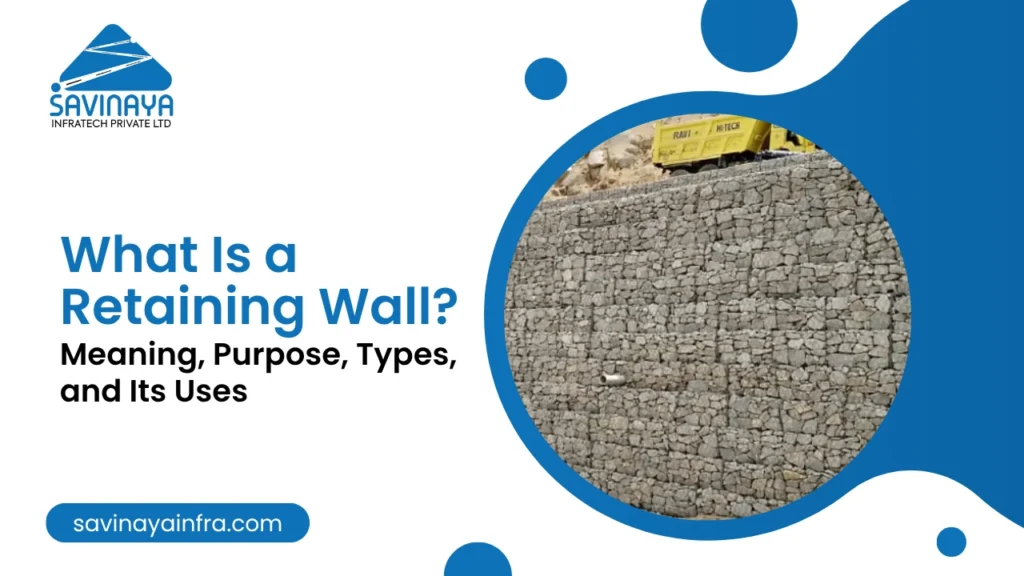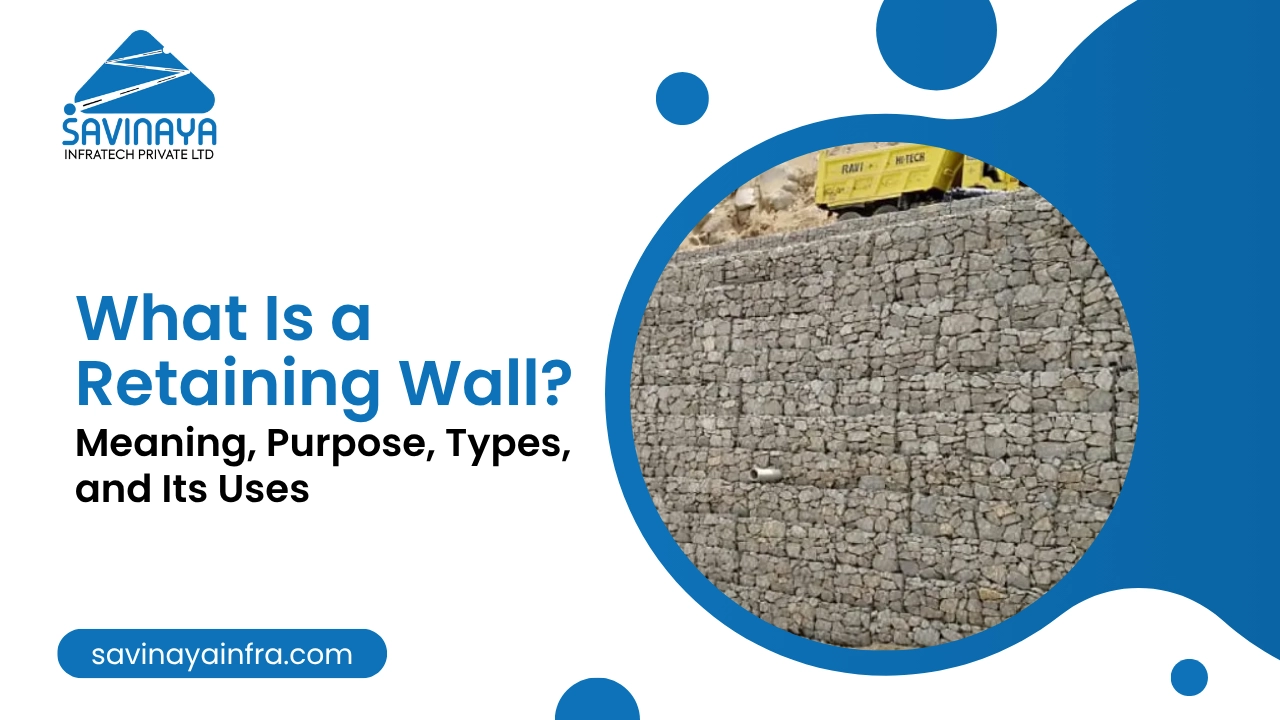
To most people, a retaining wall just looks like a sturdy structure holding back soil. But to engineers, builders, and property owners, it’s a smart solution that solves a hidden problem; land pressure.
In areas where slopes exist or soil movement poses a threat to structures, retaining walls become essential. They don’t just support earth; they shape landscapes, protect foundations, and often, save projects from collapse.
So, what exactly is a retaining wall, what does it do, and how do you know which type you need? Let’s break it down.
Key Takeaways
- Retaining walls are essential for managing soil pressure, preventing erosion, and creating usable space on sloped land.
- They serve multiple purposes: stabilizing terrain, supporting foundations, enabling terrace farming, and enhancing landscapes.
- There are several wall types: gravity, cantilever, anchored, counterfort, and sheet pile-each suited for different loads and site conditions.
- Materials range from concrete and stone to gabions and geosynthetics, depending on function, aesthetics, and cost.
- Applications include roadside embankments, basements, bridge abutments, hill roads, and industrial earthworks.
Table of Contents
What is a Retaining Wall?
A retaining wall is a structure built to resist the sideways pressure of soil or retain materials at different levels on either side. These walls are most often used to prevent soil movement on sloped ground, but they also serve aesthetic and structural purposes in landscaping and construction.
A well-built retaining wall structure does more than just look strong; it’s designed based on soil type, load pressure, water flow, and more.
What are the Purposes of a Retaining Wall?
The purpose of retaining wall design is simple: to hold back soil that would otherwise shift or slide. But in reality, the wall serves several roles, including:
- Preventing Soil Erosion: Especially in hilly or unstable terrain
- Creating Usable Space: Leveling uneven land for construction or landscaping
- Protecting Structures: Supporting nearby roads, buildings, and foundations from shifting soil
- Managing Water Flow: In some designs, they include drainage to reduce water pressure behind the wall
The functions of retaining wall construction vary depending on the site, but the end goal is always the same — stable, safe land.
What are the Types of Retaining Walls?
Not every wall works for every site. Here are the common types of retaining walls, each suited for different soil conditions, heights, and pressures:
1. Gravity Wall
Relies on its own weight to resist pressure. Typically made of concrete or stone, best for shorter walls.
2. Cantilever Wall
Uses a reinforced concrete base that extends into the soil, creating leverage. Ideal for medium to tall walls.
3. Counterfort Wall
A stronger version of cantilever walls with additional support ribs (counterforts) on the backside. Used for tall or heavily loaded sites.
4. Anchored Wall
Stabilized using anchors or tensioned cables embedded deep into the soil. Suitable for sites with limited space but high soil pressure.
5. Sheet Pile Wall
Made of steel or wood sheets driven vertically into the ground. Commonly used near water bodies or in soft soil conditions.
At Savinaya Infratech, we assess your site’s needs to recommend the most effective and cost-efficient retaining wall systems for long-term success.
What are the Benefits of Retaining Walls?
Retaining walls are essential elements in both structural and landscape design, offering a blend of functionality, safety, and visual appeal. Here’s a closer look at their key benefits:
Improved Land Stability
Retaining walls are designed to hold back soil and prevent it from moving. They are particularly valuable in hilly or sloped terrains where there’s a risk of soil erosion, surface runoff, or landslides. By resisting lateral pressure, these walls stabilize the earth behind them; protecting both landscapes and nearby structures.
Structural Safety
In civil and infrastructure projects, retaining walls play a critical role in ensuring the safety of adjacent roads, bridges, embankments, and buildings. They act as protective barriers that reduce the risk of ground collapse or slope failure, especially during heavy rains or seismic activity. This makes them an essential solution often integrated by piling contractors and foundation experts in geotechnical designs.
Interesting Reads: Best Soil Nailing Techniques for Enhancing Soil Stability in Construction
Space Maximization
On sloped or uneven land, retaining walls can create level areas for construction, parking, or landscaping. This turns otherwise unusable terrain into buildable, functional spaces, making the land more versatile and increasing its real estate value. It’s a smart solution in both urban and rural development projects.
Landscape Enhancement
Beyond their functional purpose, retaining wall design can dramatically improve the visual appeal of a property. Available in various materials such as natural stone, concrete blocks, or timber; they can be customized to complement garden layouts, walkways, patios, or commercial frontages. The added dimension and texture bring structure and elegance to the landscape design.
Water Management
Many retaining wall systems are engineered with built-in drainage features such as weep holes or geogrid layers. These help manage groundwater and surface runoff, reducing the risk of hydrostatic pressure buildup and potential damage to foundations. This makes retaining walls a smart addition on construction sites with poor drainage or heavy rainfall.
Common Materials Used in Retaining Walls
The choice of material affects the durability, cost, and appearance of a retaining wall structure. Here are the most commonly used:
- Concrete: Strong, long-lasting, and versatile
- Natural Stone: Natural and aesthetic, often used in gravity walls
- Brick: Durable and decorative
- Timber: Affordable but less durable, ideal for temporary or light-duty applications
- Gabion: Wire cages filled with rock, perfect for erosion-prone areas
- Reinforced Earth or Geogrid Systems: Often used in large infrastructure projects
Material selection depends on the retaining wall design, the environment, and the expected load pressure.
Uses of Retaining Walls
Retaining wall applications range from small landscaping projects to large-scale infrastructure developments. Common uses of retaining walls include:
Stabilizing Slopes Near Roads & Railways
In areas with steep gradients, retaining walls are essential for holding back soil and preventing landslides along highways, rail tracks, and access roads, especially during heavy rain or seismic activity.
Supporting Foundations on Uneven Ground
If you’re building a home or commercial structure on a sloped site, retaining walls can support the foundation and help create level ground for safe and stable construction.
Bridge Abutments & Flyovers
Retaining walls are a core component of bridge and flyover design. They provide lateral support where roads meet elevated structures, ensuring long-term durability and safety.
Managing Roadside Embankments
In hilly or mountainous areas, you’ll often see retaining walls lining the sides of roads. These help control erosion and keep the roadbed stable for vehicles and pedestrians.
Terrace Farming & Garden Landscaping
In agriculture, retaining walls make terrace farming possible by creating flat plots on sloped land. The same idea works in landscaping—where they add beauty, structure, and functionality to gardens.
Large-Scale Earthworks in Industrial Projects
At industrial or construction sites where large volumes of earth are cut or filled, retaining walls help manage these changes safely. They’re critical for stabilizing storage yards, retaining backfill, or managing site access.
If land movement is a risk, a retaining wall is often the first and most effective line of defense.
Interesting Reads : Gabion Walls vs Retaining Walls: What Are the Differences & Cost Comparison
How to Choose the Right Retaining Wall Type?
Choosing the right wall comes down to a few critical questions:
- What is the height and slope of the land?
- What kind of load will the wall bear? (Soil, vehicles, structures)
- What are the soil and drainage conditions?
- Is space limited on the site?
- Is this a permanent or temporary solution?
Your answers will determine the right retaining wall construction method and materials. For high-risk or engineered sites, professional design is non-negotiable. At Savinaya Infratech, we take a site-specific approach to deliver durable, safe, and cost-effective walls.
Why Choose Savinaya Infratech for Soil Nailing and Retaining Wall Services?
When it comes to retaining wall services, experience matters. Savinaya Infratech has delivered successful retaining wall and soil nailing solutions for highways, tunnels, commercial sites, and industrial zones.
Here’s why we’re trusted across India:
- Custom Engineering: Every site is different, and so custom engineering is our solution
- Advanced Techniques: We combine soil nailing with retaining walls for steep, challenging slopes
- End-to-End Support: From soil investigation to design and construction. we offer end to end support.
- Reliable Execution: On-time, within budget, and fully compliant with standards
- Proven Track Record: Our projects speak for themselves — across terrains, sectors, and challenges
As a leading retaining wall company, our goal is simple: protect what you build.
Conclusion
A retaining wall isn’t just a structure; it’s a solution. It holds back the earth, protects lives, and gives shape to spaces that once seemed unusable. But not all walls are equal. By understanding the types, materials, and functions of retaining wall systems, you can make informed choices for your land or project. And when you’re ready, Savinaya Infratech is here to build that solution with you. Get in touch with us to discuss your business needs.
FAQs
1. What is the strongest type of retaining wall?
The reinforced concrete cantilever wall is one of the strongest types, designed to handle heavy loads and high soil pressure. For challenging terrains or taller walls, anchored retaining walls provide even more strength by using deep steel anchors for support.
2. Where are retaining walls commonly used?
Retaining walls are widely used in hilly or uneven areas to stabilize soil. They’re common along highways, around basements, in landscaping projects, near tunnels, and at construction sites where land needs to be leveled or protected from erosion.
3. How long do retaining walls last?
It depends on the materials and construction quality. Concrete or stone walls can last 50 to 100 years or more. Gabion and precast systems typically last several decades, while timber walls have a shorter lifespan of around 15 to 25 years.
4. Do retaining walls require drainage?
Yes, drainage is essential. Without proper drainage, water builds up behind the wall, increasing pressure and risking failure. Most walls include gravel backfill, drainage pipes, or weep holes to let water escape safely.
5. Why are retaining walls important?
Retaining walls protect land from erosion, especially on slopes. They help create level surfaces, support nearby structures, manage water runoff, and improve land use in both residential and infrastructure projects.
6. What material do you use for retaining wall services?
We use a range of materials based on the project: reinforced concrete, natural stone, gabion systems, precast panels, and geosynthetic reinforcements. The choice depends on site conditions, load requirements, and long-term durability goals.


